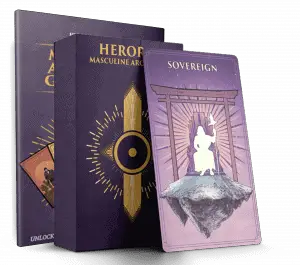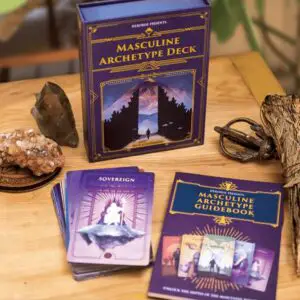The Moon is a mysterious celestial object that has been studied by many cultures throughout history. But, what about the gender of the Moon? Is it masculine or feminine? Some people believe that they are one or the other, while others say that it is both. In this article, we will explore different beliefs and interpretations of the gender of our lunar companion.
Is the moon Masculine or Feminine?
The Moon has been seen as Masculine and Feminine by different cultures across the world. Many Americans and Europeans see the moon as Feminine, but the gender of the Moon usually arises out of local myth as well as cultural norms around gender.
In America, most people see the Moon as Feminine.
I did an Instagram poll and found that 92% of people thought the Moon was feminine.
The Moon is a mysterious celestial object that has been studied by many cultures throughout history. But, what about the gender of the Moon? Is it masculine or feminine? Some people believe that they are one or the other, while others say that it is both. In this article, we will explore different beliefs and interpretations of the gender of our lunar companion.
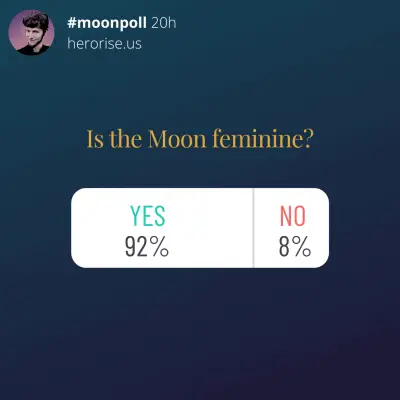
But this isn’t always the case, and different cultures have seen the Moon as Masculine – such as some native American tribes, ancient China, and Japan.
What cultures saw the Moon as Feminine?
Many cultures saw the Moon as Feminine. From classical greek to the Mayan people of Central America.
In ancient Greek mythology, the Moon is seen as Feminine.
Selene, the Titaness of the Moon, was most often depicted in a feminine form as she is shown driving a chariot with her lunar sphere or crescent crown on her head.
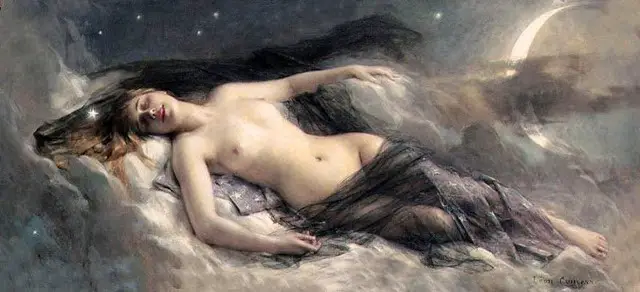
Selene, the golden goddess of the Moon, was deeply in love with Endymion. Zeus granted eternal youth and immortality to the handsome prince before he was left asleep by Latmos’ mount peak. Selene visited him at night in his cave, and they were together every night.
The kabbalistic interpretation of the Moon is that it gives reflective light, which is a quintessentially feminine trait.
This connection is also seen in Christian iconography, where the Virgin Mary has been linked with the moon. Mary has often been portrayed as standing on top of the crescent moon.
Below is a list of what cultures viewed the Moon as Feminine and goddesses that represented the Moon.
Feminine Moon: Cultures and Goddesses
| Culture or Region | Female Goddess |
| African, Dahomey | Mawu |
| Aztec | Coyolxauhqui |
| Greek | Artemis |
| Greek | Selene |
| Mayan | Ix Chel |
| Roman | Diana |
| Sami | Mano (or Manna) |
What cultures saw the Moon as Masculine?
Ancient cultures, such as the Norse and Egyptians, see the Moon as Masculine, but there are also modern-day examples. Germany, for instance, considers the Sun to be Feminine and the Moon as masculine.
In South-Slavonian poetry, the Sun was seen as the bride to the masculine Moon.
My mother is–the beauteous Sun,
And my father–the bright Moon;
My brothers are–the many Stars,
And my sisters–the white Dawns.
From the Russian Fairy Tales, by W. R. S. Ralston
In Ancient Egypt, Thoth was seen to rule over the Moon. He was a god of knowledge and represented the Moon in its waning phases when it is no longer seen as full and round but thinning as if to disappear entirely.
The Sumerians viewed the god Su-en as a representation of the Moon. He was one of the most important deities in the broader pantheon of Mesopotamia. The primary symbol of the moon god was a bull, the result of the horizontal crescent of the waxing Moon appearing similar to the horns of that animal.
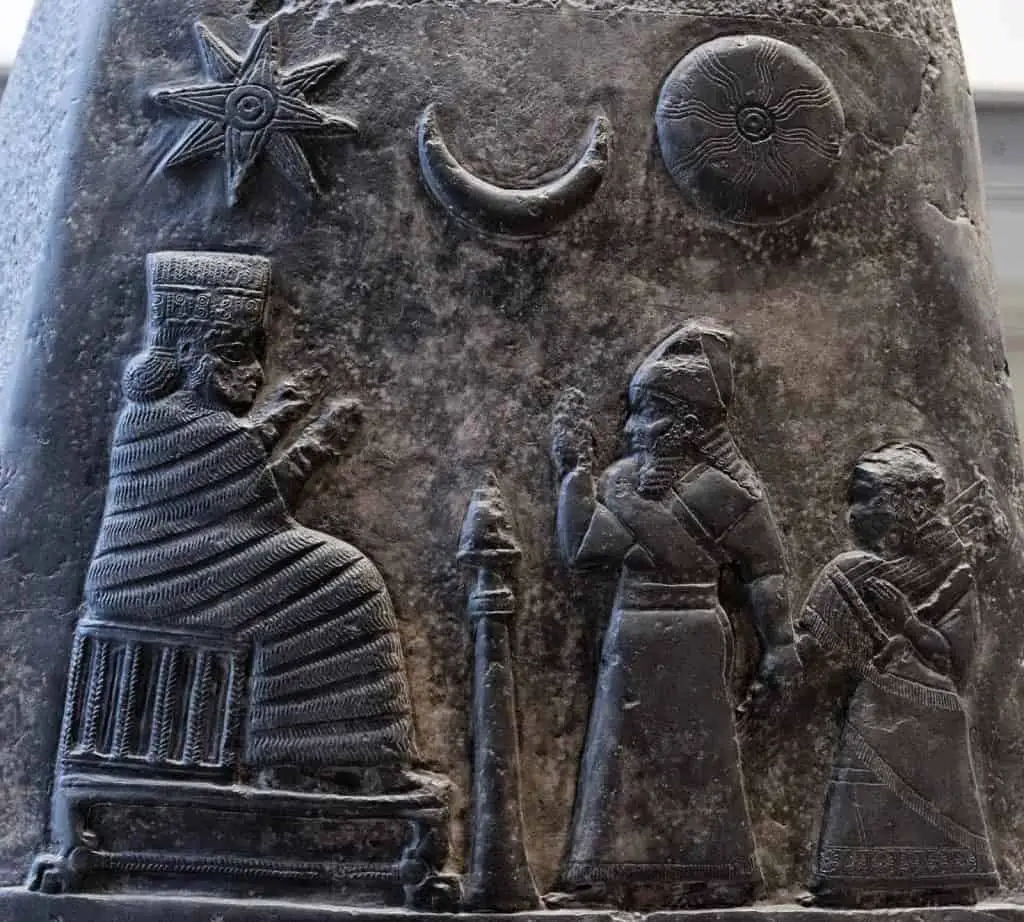
Learn More about Ancient Masculine Symbols
Below is a list of what cultures viewed the Moon as Masculine and gods that represented the Moon.
Masculine Moon: Cultures and Gods
| Culture or Region | Male God |
| Egyptian | Khonsu and Thoth |
| Hindu | Chandra |
| Japanese | Tsukiyomi |
| Norse | Máni |
| Slavic | Jutrobog |
| Sumerian | Su-en (or Sin or Nanna) |
| Western Asia Minor | Mên |
Why do some cultures see the Moon as Female or Masculine?
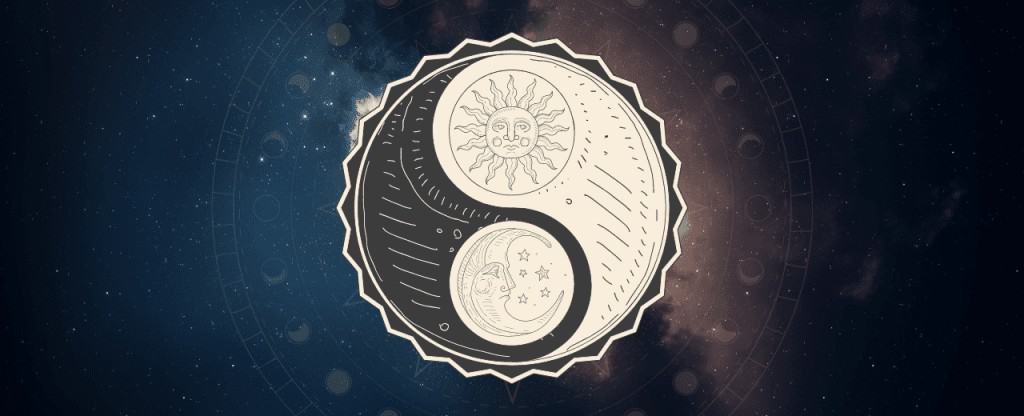
Symbols have meaning because we connect significance to the image.
Often, this process of creating meaning and myth emerges from unique languages and the cultures they came from.
Some cultures see women as being more emotional than men, with the ability to feel and sense things like mood changes far better than men.
Another reason why many cultures associate the Moon as female is because many women’s menstruation cycles are synced with phases of the Moon. This, coupled with the idea that the Moon is emotionally receptive, has led many people in modern spiritual communities to view the Moon as Feminine.
Alternatively, some cultures believe that when the Moon is waxing, it looks like a male figure with horns.
In ancient times, many people believed these horns of the male bull and symbolized strength. Because this shape looked masculine or, many people began associating the Moon phase with masculinity. Some cultures also viewed the Moon as representing (silent) strength, wisdom, change, and sometimes death.
Our ancestors also feared the night for a good reason. The Moon was sometimes seen as a protective blessing from a sky god to help them survive the night.
Does the Sun always represent the Opposite Gender of the moon?
In almost every culture that has the moon represented by a gender (ex. Feminine) the sun is represented as the opposite gender (ex. Masculine).
A great example of this is greek mythology. The Sun was represented by the masculine god Helios, and the moon by the feminine goddess Selene. In Norse mythology, for example, Sol (also called Sunna) is the goddess of the sun and driver of a golden chariot. While her brother, Mani, is the god of the moon.
There are however some cultures that have the Sun and Moon represented as both Masculine deities. The Japanese Shinto moon god, Tsukiyomi, was born from the right eye of the creator god Izanagi. He was the brother of the sun goddess Amaterasu.
Or in Sumeria, the god Utu is the god of the sun and his counterpart was Su-en, the moon god.
In most myths, however, the sun and moon represent opposite genders of one another.
Moon Gender and Language
Many languages make use of Grammatical Gender. This is when a language system adds a gender class to a word. Such as giving nouns a male or female prefix or special modifiers to signify the gender of the object.
Example:
- English: Moon is neutral and referred to as an “it”
- French: the moon is “La Lune” ( La being feminine) and the sun is “Le Soleil” (Le being masculine).
- German: the moon is “Der Mond” (Der being masculine) and the sun is “Die Sonne” (die being feminine).
Looking at Grammatical Gender can be an interesting way to see how different cultures preserve the moon.
In the Romance languages (such as Latin, Greek, French, Italian and Portuguese), assign a masculine gender for “Sun” and feminine for “Moon.”
The Moon is masculine and the Sun feminine in other Indo-European languages, similarly to how it was in very ancient Ancient Sumerians.
In contrast, other Indo-European languages have a masculine Moon and feminine Sun. For example, German spells “moon” as “Mond”, while Old Goidelic spells “Moon” as either “Nosu” or “Sin,” both of which are masculine nouns. This trend continues in the Sumerian language, in which their words for “sun” and “moon” have the same gender.
In Conclusion
I believe we attribute different traits to the Moon based on how we see masculinity as a culture. It is built from the cultural construct of masculinity. The Moon, like most of us, could also be seen to have both masculine and feminine within it.
I have personally had many evenings under a full moon and felt a deep feminine presence. I have become a “lunatic” by staring at the Moon too long – causing restless nights.
We can gain a lot of meaning by connecting to the natural rhythms of celestial bodies. The Moon can be a powerful tool to understand our own masculine and feminine energies. It’s just important to realize our experience is but one of many interpretations.
If you are genuinely interested in exploring the mysteries of the Moon, I suggest sitting in silence and breathing deep the lunar light on a full moon. Notice how you feel and react. It’s something better felt than explained.
